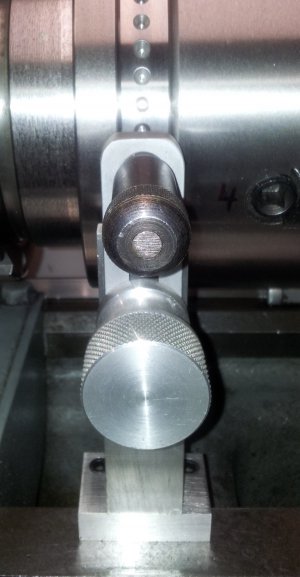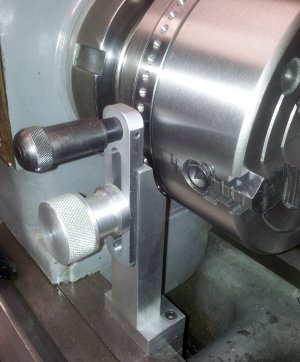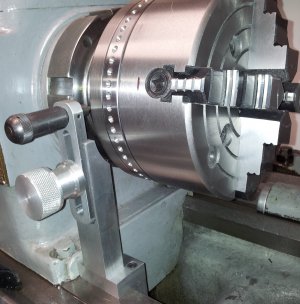- Joined
- Dec 1, 2010
- Messages
- 1,172
Hi Guys
I have added a new addition to my lathe for doing simple indexing. I allready have a set up for the LH end of the spindle, that takes a expanding spindle plug, and dividing plates, but wanted something thats easy, and fast to use. In my crowded work area, its not allways easy to get to the LH end of my machine, and the time to get it all set up to use it. If it takes to long, I might as well just take the job over to the mill and do it there. I dont enjoy tearing down a setup to do the next operation, and some times the mill allready has a in progress job still in it.
My Spindle is a L-1 type, and most all of my chucks are mounted up with a adapter plate as shown in these pics. This plate has be drilled,milled,and chamfered for 60 holes, at 6 degree spacing. With 60 holes, it gives me the most divisions that I most commonly use. It will do 2,3,4,5,6,10,12,15,20,30,60 divisions.
Though this wont cover everything, it does common used divisions like 3,4,5,6,10,12 For many jobs this will speed up the process of putting in a say , a 5 bolt pattern in a part, without taking it out of the lathe chuck, and heading over to the mill. My tool post driller will get much more use with this addition. Bolt circles of the available divisions will be completed on the lathe. For the other divisions that this 60 hole job wont do, I still have the set up for the LH end that uses dividing plates, and some times gears.
Anyway here,s a few pics. The spring loaded handle shown, a part used on my rotary table for dividing with plates, will have a mount that clamps to the flat way directly in front of the chuck, That will have vertical ajustment to centre up the pin to lock the position.
I did this on the 8 inch 4-jaw chuck adaper plate, as I use the 4-jaw most.



I have added a new addition to my lathe for doing simple indexing. I allready have a set up for the LH end of the spindle, that takes a expanding spindle plug, and dividing plates, but wanted something thats easy, and fast to use. In my crowded work area, its not allways easy to get to the LH end of my machine, and the time to get it all set up to use it. If it takes to long, I might as well just take the job over to the mill and do it there. I dont enjoy tearing down a setup to do the next operation, and some times the mill allready has a in progress job still in it.
My Spindle is a L-1 type, and most all of my chucks are mounted up with a adapter plate as shown in these pics. This plate has be drilled,milled,and chamfered for 60 holes, at 6 degree spacing. With 60 holes, it gives me the most divisions that I most commonly use. It will do 2,3,4,5,6,10,12,15,20,30,60 divisions.
Though this wont cover everything, it does common used divisions like 3,4,5,6,10,12 For many jobs this will speed up the process of putting in a say , a 5 bolt pattern in a part, without taking it out of the lathe chuck, and heading over to the mill. My tool post driller will get much more use with this addition. Bolt circles of the available divisions will be completed on the lathe. For the other divisions that this 60 hole job wont do, I still have the set up for the LH end that uses dividing plates, and some times gears.
Anyway here,s a few pics. The spring loaded handle shown, a part used on my rotary table for dividing with plates, will have a mount that clamps to the flat way directly in front of the chuck, That will have vertical ajustment to centre up the pin to lock the position.
I did this on the 8 inch 4-jaw chuck adaper plate, as I use the 4-jaw most.



Last edited:

























